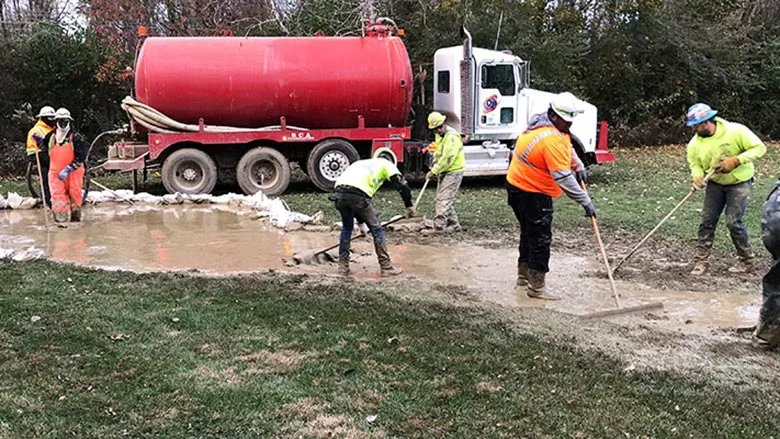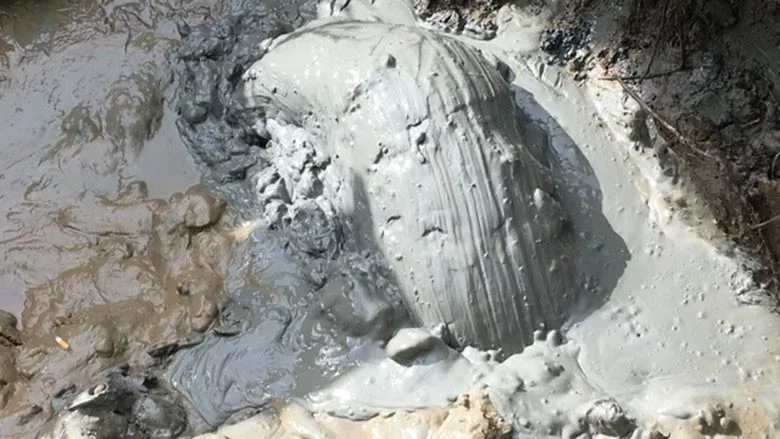Managing Viscosity
Connecting the dots between thick drilling fluids, thick high-density returns, and high annular pressures

Photo courtesy of CETCO

Photo courtesy of CETCO
As we move forward into the new year, it's a good idea to rehash older topics and refresh our memories about a subject that doesn't get enough attention on a day-to-day basis: high-density/high solids drilling fluid returns and its effect on the drilling process. We've all seen it before where a large solid plug of clay or a semi-solid mix of silt and sand that looks like pudding comes out of the borehole, and then in the blink of an eye, loss of circulation and or inadvertent returns (frack out for us older drilling guys) pops up along the bore path. Afterward, it's all hands on deck with squeegees and hydro-vacs trying to clean up the mess while dealing with the stuck drill pipe and all the other attributes that come with high-density drilling fluid pressures exceeding what the formation can withstand..
Be it vertical or horizontal directional drilling, the goal is to excavate a borehole by removing the existing soil so that a product can be installed. As the bit or reamer cuts into the formation, it also mixes drilling fluid and soil together into what needs to be a flowable mixture that can transport drill cuttings to the surface. Drilling fluid must be matched to soil conditions to maintain borehole integrity, control reactive clays, and suspend and transport drill cuttings to the surface. Like drilling fluids, pumping volume must also be matched to soil conditions to maintain flowable drilling fluid returns that will not raise annular pressures, which can cause many problems.
Matching drilling fluids and pumping volumes to soil conditions is as easy as separating soil conditions into two basic categories: non-reactive or coarse soils (sand, gravel, rock) and reactive or fine soils (clays and silts). Problems with non-reactive/coarse soils include fluid loss (borehole stability) and suspension of heavy solids. Non-reactive/coarse soil conditions require two to three times the amount of drilling fluid for excavated soil. In contrast, fine/reactive soil conditions require three to five times the amount of drilling fluid versus the soil excavated to maintain a flowable return mixture due to clay formations' reactive (swelling and sticking) nature.
For example, using a 12-inch reamer, the soil volume per foot drilled is calculated as follows: 12 x 12 = 144 ÷ 24.5 = 5.88 gallons/foot. This tells us that 5.88 gallons of soil must be displaced and mixed into a flowable slurry with drilling fluid for every foot drilled. Reactive soils (clays, shales, mudstone) require a ratio of 3:1 to 5:1 of drilling fluid versus soil to move cuttings out of the hole efficiently. At a ratio of 4:1, 23.52 gallons per foot of hole reamed is required to maintain a flowable return mixture. For coarse unconsolidated soils (sand, silt, coarse sand, gravel), the ratio is 2:1 to 3:1 of fluids to be pumped to move the cuttings out of the hole; therefore, at 2:1, you need to pump 11.76 gallons per foot of hole reamed. Generally, drilling fluids for reactive clays have a lower viscosity and contain additives to inhibit the sticking and swelling or additives that will break the clay down. Non-reactive coarse soils generally have a higher viscosity and require higher gel strength to suspend heavier solids, along with better fluid-loss control to stabilize loose unconsolidated formations and prevent the hole from collapsing. Using the correct additives to enhance fluid loss and gel strength can create a drilling fluid that can perform these functions at a lower viscosity and reduce annular pressures.
The pull-back speed for a back reamer on a horizontal directional drill is limited by the amount of drilling fluid pumped to the reamer. If the reamer is cutting more soil than the delivered drilling fluid can adequately mix into a flowable slurry, the driller is outrunning the drilling fluid, and the return flow becomes thick and heavy with drill cuttings. Clean drilling fluid has a weight of around 8.4 to 8.6 pounds per gallon, whereas drilling fluid returns from a horizontal directional drilling operation can be more than 14 pounds per gallon, which will require higher annular pressure to push out of the borehole. The definition of the word viscosity is the resistance of a fluid to flow, and it is the resistance of flow with high density/high solids/high viscosity drilling fluid returns that result in over-pressuring the formation and drilling fluid fracturing through to the surface.
The best way to prevent this is to start with a drilling fluid that performs all the necessary functions at lower viscosities (as previously mentioned) and retain someone who is in constant contact with the driller to monitor the return flow. Suppose the return flow becomes excessively thick and heavy. In that case, they can inform the driller, who can either increase the pumping volume or slow the back ream speed to reduce the viscosity and density of the return flow, which will decrease annular pressures to reduce the chances of fracking out. Monitoring the return flow can also be helpful when unexpected soil conditions are encountered, as adjustments to the drilling fluid mixture can be made.
Check out more Drilling Fluids Tips!
From the mix tank to the return flow, managing viscosity (the resistance of a fluid to flow) is crucial in controlling frack outs and is critical to a successful bore. Managing viscosity starts with drilling fluids that perform all necessary functions at a lower viscosity by using the proper additives and ends with monitoring the return flow to ensure that back ream speed does not outrun the drilling fluid. Keep turning to the right, and a great 2024 season to all the drillers out there, ensuring we have the services we need.
Looking for a reprint of this article?
From high-res PDFs to custom plaques, order your copy today!




